The majority of Antonio Galloni’s Bordeaux 2017 scores have been added to Wine Lister. The release of his Saint-Emilion satellites will complete Vinous’ coverage of Bordeaux en primeur 2017. Below is an overview of his top-scoring wines so far for this vintage:
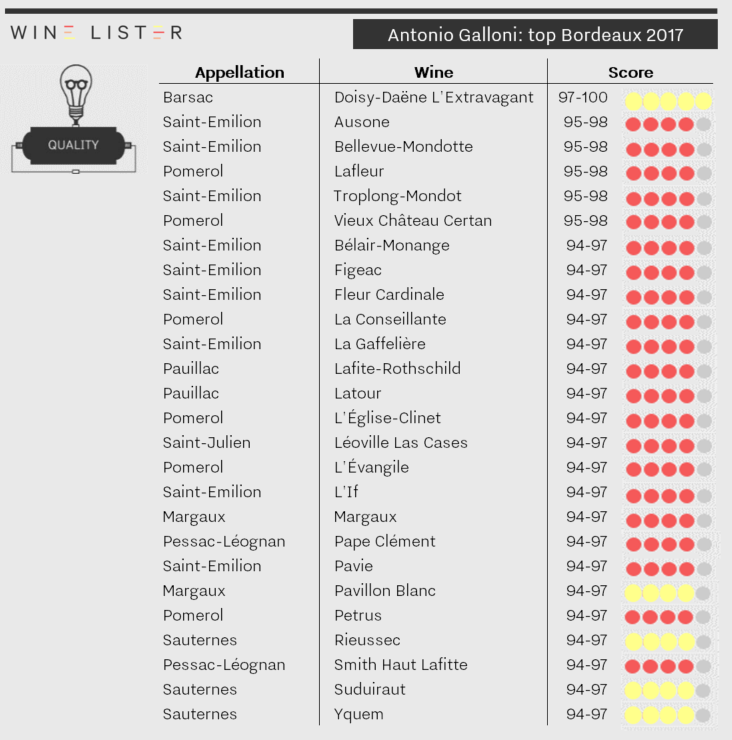
The only potential perfect scorer is Doisy-Daëne L’Extravagant (97-100). This strengthens the case for the Sauternes & Barsac appellations as the biggest successes of the 2017 vintage (see top scores from Bettane+Desseauve, Jancis Robinson and Neal Martin for comparison).
Five wines scored 95-98 points, and they are all from the right bank, which Galloni explicitly declares to be superior to the left bank in 2017. Lafleur, released today exclusively by Justerini & Brooks, achieves the top score bracket for a red wine from all four of Wine Lister’s partner critics, making it the red wine of the vintage.
It is joined at the top of Galloni’s picks by Ausone, Bellevue-Mondotte, Troplong-Mondot, and Vieux Château Certan.
The next score category, 94-97, is also dominated by the right bank, featuring 10 wines from Saint-Emilion or Pomerol and just six red wines from across the whole of the Médoc and Graves. The surprise entry is L’If, from the Thienpont family, which outscores its venerable older sibling, Le Pin (93-96).
Three left bank first growths make the cut: Lafite, Latour, and Margaux. Alongside its big brother, Pavillon Blanc is Galloni’s top scoring dry white 2017, also achieving 94-97 points.
Other wines scoring 94-97 from Antonio Galloni include: Bélair-Monange, Figeac, Fleur Cardinale, La Conseillante, La Gaffelière, L’Église-Clinet, Léoville Las Cases, L’Évangile, Pape Clément, Pavie, Petrus, Rieussec, Smith Haut Lafitte, Suduiraut, and Yquem.
All these scores are now live on the wine pages of our website for subscribers to view (alongside those of Bettane+Desseauve, Julia Harding MW and Neal Martin), with links through to Antonio Galloni’s tasting notes on Vinous.com. Have a look at Antonio Galloni’s coverage of Bordeaux 2017 here. NB. As Jeannie Cho-Lee did not taste the 2017 Bordeaux, Antonio Galloni’s scores complete Wine Lister’s Quality scores for the vintage.
While the wine world lives and breathes Bordeaux during this year’s en primeur season, Wine Lister looks at some high-scoring Bordeaux reds that could easily be overlooked amidst the sea of releases to choose from across Médoc classified growths and beyond. Below we examine the top five fourth growths by overall Wine Lister score.
The highest-scoring Bordeaux fourth growth on Wine Lister is Château Beychevelle, with a score of 879. Its trailing Quality score of 790 is boosted by Brand and Economics scores of 980 and 904 respectively. Meanwhile, Beychevelle’s 2016 and 2015 vintages achieve Quality scores more than 15% higher than its wine-level average. It will be interesting to see how the 2017 vintage (with a Quality score of 805 thus far, based on partner critics Bettane+Desseauve, Neal Martin and Julia Harding MW for Jancis Robinson) is priced during this year’s en primeur campaign in the coming weeks.

In second and third place are Château Talbot and Château Branaire-Ducru, achieving Wine Lister scores of 859 and 842 respectively. Talbot is the most popular of the five, receiving 14,602 searches each month on Wine-Searcher, resulting in the group’s best Brand score (983). Talbot’s position as a ubiquitous Bordeaux brand is no doubt helped by a production level of c.400,000 bottles per annum – over twice as many as Branaire-Ducru.
The fourth entry and only Pauillac to feature, Duhart-Milon, has the lowest Quality score of the five (752), but carries a Brand score of 916 points. It is no surprise that, as part of the Lafite group, it is the most-traded Bordeaux fourth growth at auction, its top five vintages having traded 1,186 bottles over the past four quarters.
Finally, Lafon-Rochet appears in the Listed blog for the second week in a row (previously featuring in the top five Saint-Estèphes by Economics score). At 800 exactly, Lafon-Rochet’s Wine Lister score is safely in the “very strong” category on the 1,000-point scale. In the context of this week’s top five it has the third-highest Quality score (770), but its price per bottle is 41% below the rest – a savvy buy!
Bordeaux 2017 en primeur scores are now out from Neal Martin for Vinous.com – our US partner critic, and one of the most prominent voices of international wine criticism today. (Antonio Galloni’s scores are due out this Thursday, 3rd May). This is the first time Wine Lister has featured Neal Martin’s scores after he joined Vinous in February this year. Below are his scores equal to or above 94-96:
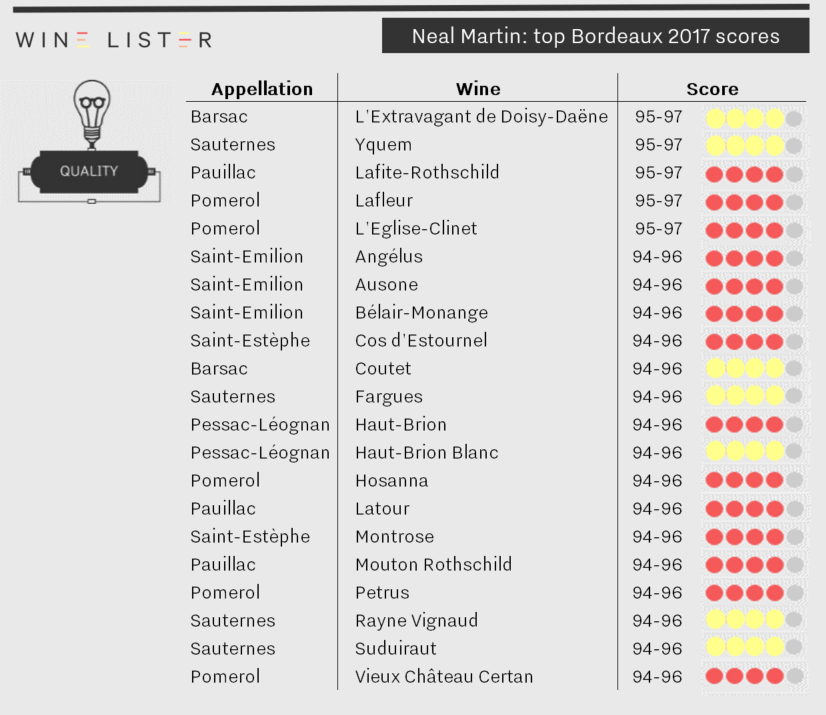
No wines earned perfect scores this year (in contrast with 2016, where Martin awarded a potential 100 points to eight wines), with five wines achieving Martin’s highest potential score of 97.
With a score of 95-97, Yquem sits in the top score bracket for the third time, already awarded 18.5 and 19.5-20 by Julia Harding MW (on behalf of Jancis Robinson) and Bettane+Desseauve respectively.
Similarly to Bettane+Desseauve, Martin’s appreciation for the quality of Sauternes and Barsac in 2017 is clear, with five other sweet whites making his top 21 (L’Extravagant de Doisy-Daëne, Coutet, de Fargues, Rayne Vignaud, and Suduiraut).
Lafite is Martin’s highest scoring Médoc first growth, which he describes as “classic from start to finish”. Joining the high rankings are first growths Haut-Brion (and its white), Latour, and Mouton, all earning 94-96 points.
The right bank figures strongly too. Two Pomerols (Lafleur and L’Eglise-Clinet) equal Lafite’s score, with three more earning 94-96, alongside three wines from Saint-Emilion. Ausone, like Yquem, makes its third appearance in top scores for Bordeaux 2017 from Wine Lister partner critics. “What a great Ausone this is destined to be,” comments Martin.
Bélair-Monange is perhaps the stand-out entry, described by Martin as, “the jewel in the crown of J-P Moueix… an assured, and bewitching Saint-Emilion”.
Other wines scoring 94-96 from Neal Martin include: Angélus, Cos d’Estournel, Hosanna, Montrose, Petrus, and Vieux Château Certan.
All these scores are now live on the wine pages of our website for subscribers to view (alongside those of Bettane+Desseauve and Julia Harding), with links through to Neal Martin’s tasting notes on Vinous.com. Read Neal Martin’s coverage of Bordeaux 2017 here.
Vinous coverage will be completed by Antonio Galloni’s scores, due for release on Thursday 3rd May.
Bordeaux 2017 en primeur scores are now out from Julia Harding MW for JancisRobinson.com – our UK partner critic (Jancis Robinson herself was kept in London updating the World Atlas of Wine for its next, eighth edition).
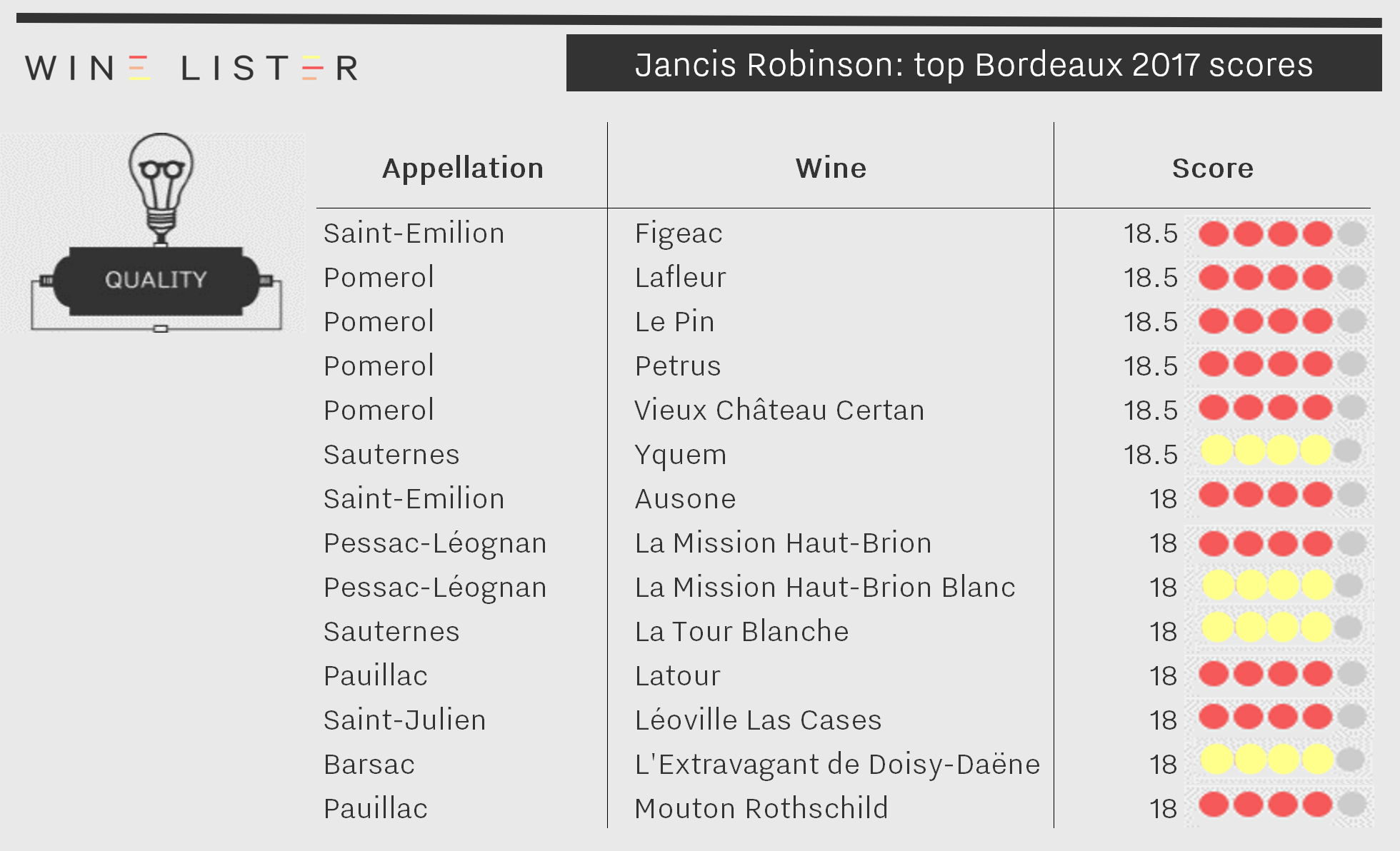
Harding awarded 14 wines a score of 18 or above, with Pomerol the most featured appellation at the top of her scoreboard. Lafleur, Le Pin, Petrus, and Vieux Château Certan all scored 18.5, the highest score given by Harding to any Bordeaux 2017 (while last year Robinson granted seven 2016 Bordeaux 19 points, including four of Harding’s favourites this year).
This Pomerol quartet is joined by another right bank wine, Saint-Emilion Premier Grand Cru Classé B, Figeac, whose tasting note from Harding ends: “Silky, charming, mouth-watering. So succulent, so precise, unforced.”
The only other wine to score 18.5 is the king of Sauternes, Yquem. As we saw in yesterday’s blog summing up Bettane+Desseauve’s top scores, 2017 is successful vintage for sweet whites. Harding’s top wines include La Tour Blanche and Doisy Daëne’s tiny production Barsac – already released at £140 per half bottle – L’Extravagant.
Like our French partner critics, Harding also gives high scores to Ausone, Latour, La Mission Haut-Brion Rouge, and its white sibling – the only dry white in her top table. Mouton Rothschild and Léoville Las Cases also score 18 points.
All these scores are now live on the wine pages of our website for subscribers to view (alongside those of Bettane+Desseauve), with links through to Harding’s tasting notes on JancisRobinson.com. Read Jancis Robinson’s extensive Bordeaux 2017 coverage here.
Neal Martin’s and Antonio Galloni’s scores will be added on Tuesday and Thursday respectively.
This week, Wine Lister determinedly battles through the cold to bring on spring with the vinous ray of sunshine that is Sauvignon Blanc. The Loire valley is, for many, the holy grail of Sauvignon Blanc production, creating pure, age-worthy examples of the grape. Interestingly, Wine Lister’s top five Loire Valley dry whites for Quality all hail from the Easternmost tip of the Valley – Pouilly-Fumé and Sancerre – thus edging out stiff competition from the more Westerly Chenin Blancs.
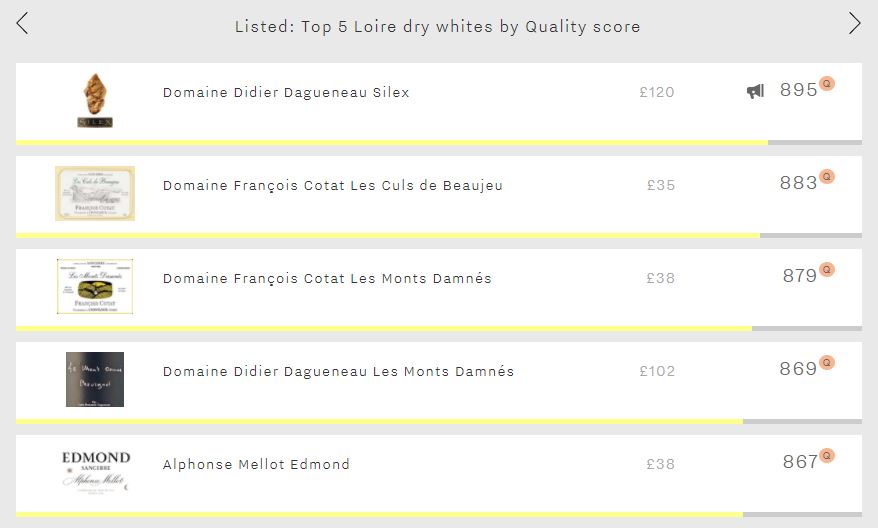
Whilst none of the top five breach the 900-point mark – thus not quite making it into the most elite band of Wine Lister’s 1,000-point scale – they don’t miss out by far, and are separated by just 28 points. Notably, two producers dominate – Dagueneau and François Cotat – filling four spots, with Alphonse Mellot’s Edmond taking the remaining place.
In top spot is Dagueneau’s Silex with a score of 895. This iconic Pouilly-Fumé – or Blanc Fumé de Pouilly as the domaine refers to it – might not be the Loire’s longest-lived dry white, but leads thanks to excellent critics’ ratings, with French duo Bettane+Desseauve awarding it 18.5/20 on average. Not only is it the Loire’s top dry white for quality, it also achieves the best Brand score of any Loire Valley wine – it is 68% more popular than any other wine from the region and its famous flint-emblazoned bottle is visible in 39% of the world’s top restaurants.
Second and third spots are taken by two Sancerres from François Cotat – Les Culs de Beaujeu (883) and Les Monts Damnés (879). François Cotat, along with his cousin Pascal inherited their respective domaines when their fathers – Paul and Francis – retired in the early 90s. The cousins decided to split production, with François continuing to make his wines in Chavignol, whilst Pascal built a new winery in Sancerre. François’ Les Culs de Beaujeu and Les Monts Damnés comfortably achieve the longest drinking windows of this week’s top five – 12 and 13 years respectively – at least three years longer than the remainder of the group.
Fourth and fifth spots are filled by Dagueneau’s Les Monts Damnés (869) and Alphonse Mellot’s Edmond (867). Whilst they are separated by just two points in terms of Quality, the former is over 2.5 times more expensive, perhaps thanks to Domaine Dagueneau’s cult status.
The Bordeaux 2015 vintage broke a more lacklustre run since the formidable 2010, and seemed to prove the wine trade legend of vintages ending in 5. En primeur tastings took place at the crest of “Bordeaux Bashing”, with some journalists reluctant to praise the vintage too highly, and there was talk of inconsistency between appellations. Saint-Estèphe was said to have suffered from more rain than its southerly neighbours, for example. Meanwhile in Saint-Emilion, a lack of homogeneity allowed each wine to express its terroir and its identity to the utmost.
Now that the wines have been bottled, it seems a suitable time to revisit the vintage. Our CEO, Ella Lister, has just got back from tasting over 200 wines from across the two banks with Wine Lister’s partner critics Michel Bettane and Thierry Desseauve. She reports Saint-Estèphe as “exceptional and wrongly dismissed as rained-out”, and names Figeac and Canon as two highlights, both “stunning”. The two Saint-Emilion wines are among the top five Quality scores for the vintage on Wine Lister.
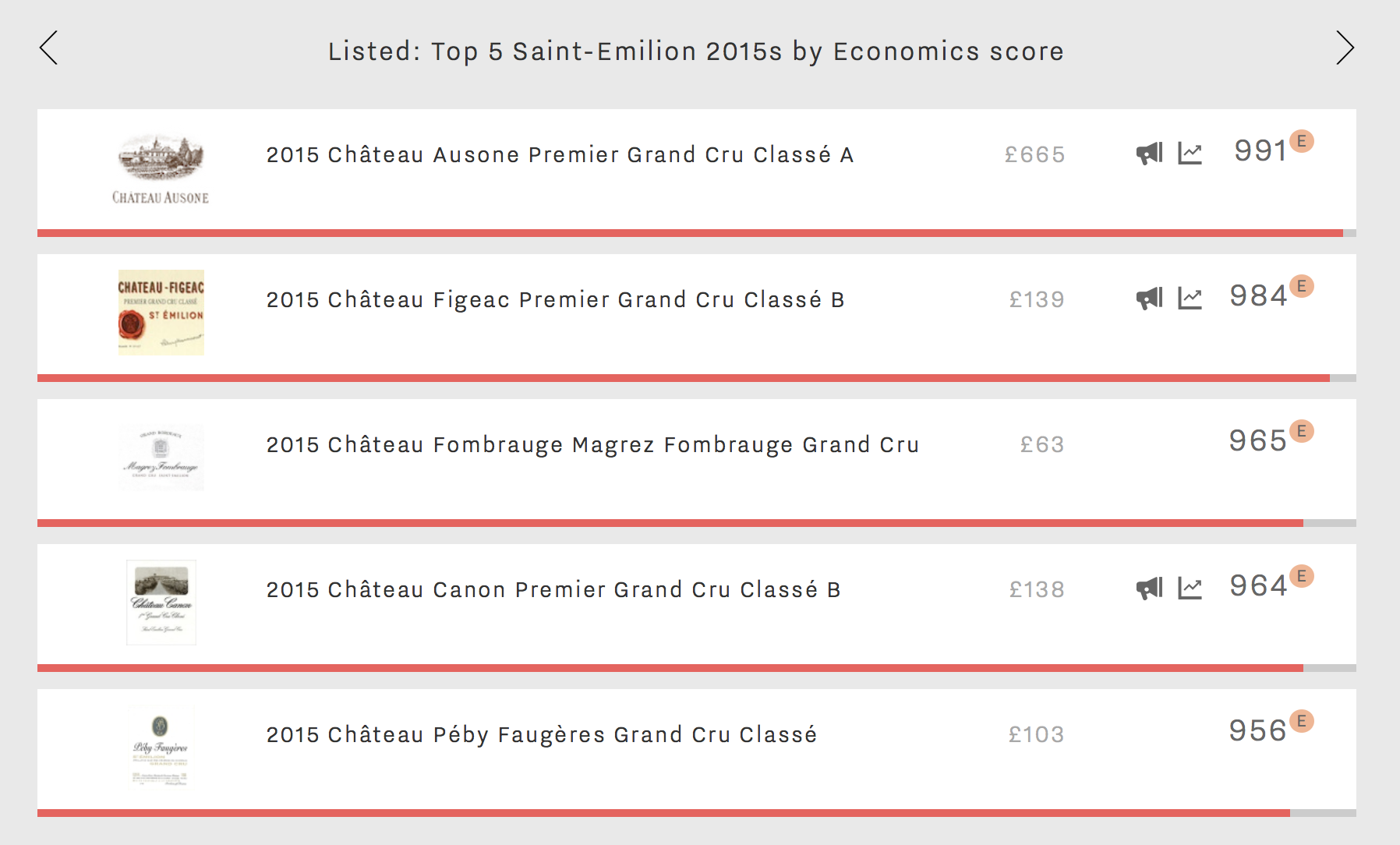
Figeac and Canon both also feature in this week’s top 5: Saint-Emilion 2015 Economics scores, showing that the market recognises their worth. Coming in second and fourth place, both hold premier grand cru classé B status since the reclassification of Saint-Emilion in 2012. Château Figeac 2015 achieves its best Economics score to date with an impressive six-month price performance of 18%.
However, Château Canon is the real surprise here. One of the most talked-about wines by the fine wine trade, its Wine Lister scores are improving from vintage to vintage, with its Economics scores, in particular, soaring. It comes in second place among all Bordeaux wines for Economics score in the 2016 vintage. Both Figeac and Canon are Buzz Brands and also Investment Staples (two of the four Wine Lister Indicators), and so is number one on the list…
Beating both of these is premier grand cru classé A, Château Ausone, with an Economics score of 991 – a record high for this producer, even against the strong 2005 vintage. The château also gains the number one spot across all Saint-Emilion 2015s in Quality, with a score of 990. In the context of overall Wine Lister scores, Ausone is just behind Petrus and Margaux as the third highest-scoring Bordeaux of 2015.
Magrez-Fombrauge and Péby Faugères are the ‘underdog’ entries among Saint-Emilion Economics performers. With Quality and Brand scores ranging from average to strong, the overall score of both wines is “strong” according to the Wine Lister 1,000-point scale (the other three entries sit comfortably in the “strongest” category, with overall scores significantly above 900).
In contrast, one might expect some bigger names, such as Cheval Blanc (a Wine Lister Buzz Brand) to appear higher up the list. Its Economics score of 946 puts it in seventh place, with slower price growth (3% over the last six months). Its price per bottle currently stands at around £500, over five times higher than that of Péby Faugères, and seven times more than Magrez-Fombrauge.
As we edge ever closer to Christmas, it feels appropriate to take a look at sweet wines. Here we consider Alsace’s top 5 sweet whites by overall Wine Lister score. Produced in a thin sliver of land in the far East of France, Alsace’s top sweet whites are separated by just nine points (less than one hundredth of Wine Lister’s 1,000-point scale!). The five wines display very similar profiles, all outperforming in the Quality category, achieiving middling Brand scores, and trailing economically.
Four break the 900-point boundary in terms of Quality scores, putting them amongst the very top quality wines on Wine Lister. Hugel et Fils Riesling Vendange Tardive (VT) falls just short with 881 points, still a very strong Quality score (thanks to 17/20 from both Jancis Robinson and Bettane+Desseauve, and 92.5/100 from Vinous). The same producer’s Gewürtzraminer VT scores even higher for quality (910) thanks to a 95/100 from Jeannie Cho Lee:
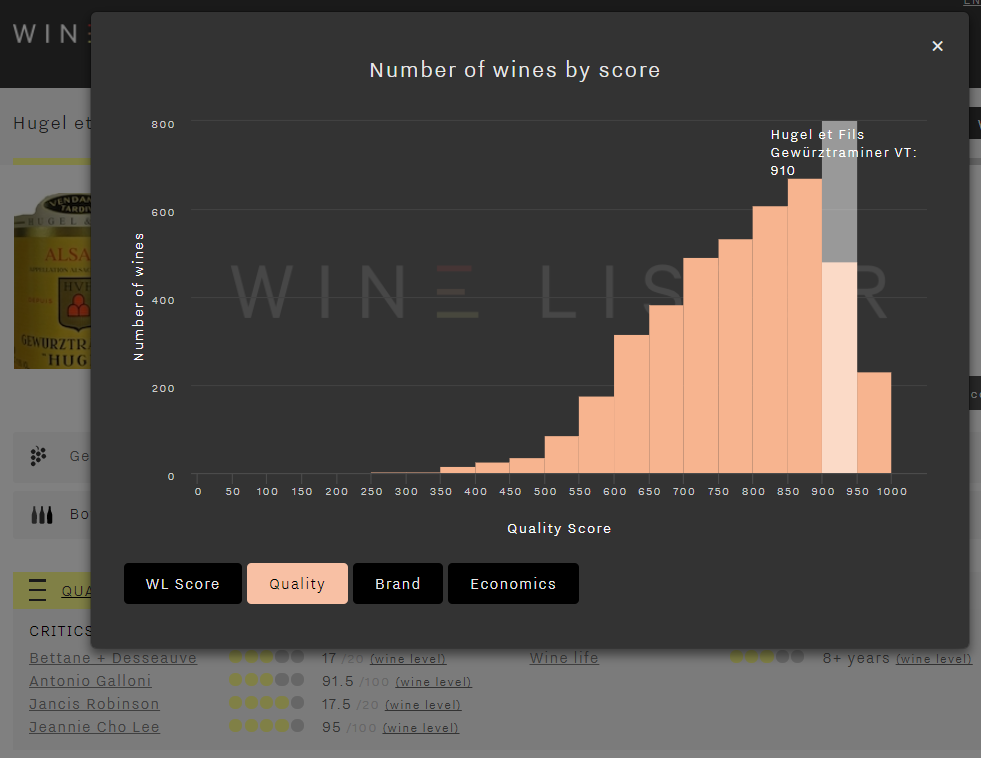
Moving categories, scores drop sharply from an average Quality score of 915 to 550 for Brand – still above the average for all wines on Wine Lister:
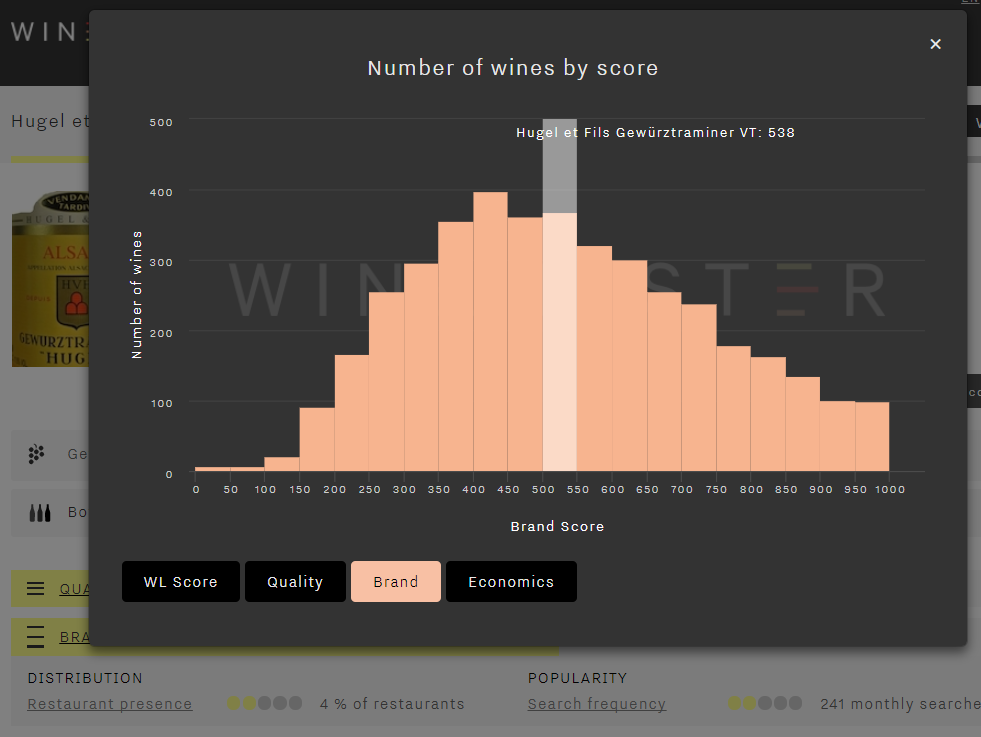
Economics scores trail even further behind, averaging 338, hindered by low liquidity. For example, Hugel’s Gewürtzraminer VT failed to trade a single bottle at auction over the past four quarters (as measured by Wine Market Journal). The chart below shows Economics score in the context of all the wines on Wine Lister – its is well below the average, with a score below 400 putting in the “weak” score band:
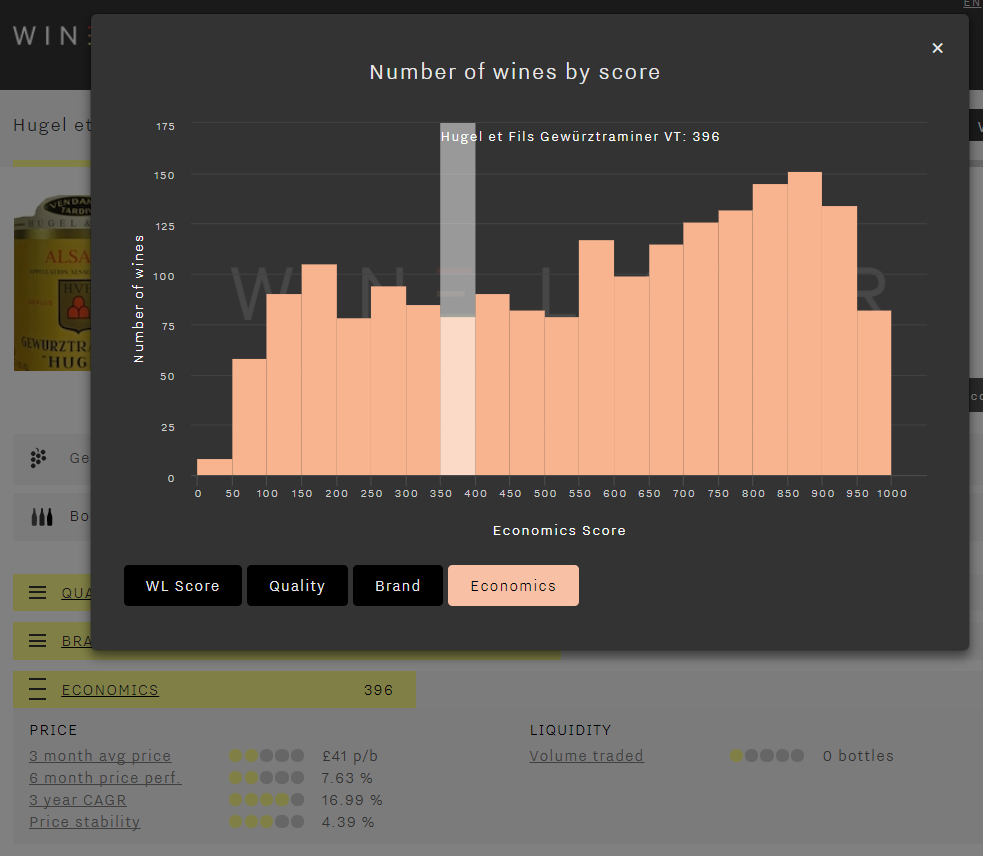
Other wines making the top five are Zind-Humbrecht Jebsal Pinot Gris VT (675) and Trimbach Gewürztraminer VT, which achieves the best restaurant presence of the group. However, featuring on just 6% of the world’s best restaurant lists, this suggests that Alsace’s sweet whites are not every sommelier’s must-list bracket, even when produced by the region’s most famous producer. Incidentally, Trimbach’s Clos Sainte Hune appears in 34% of wine lists (compared to 69% for Sauternes’ Château d’Yquem).
The last wine making it into this week’s Listed section is Marcel Deiss Altenberg de Bergheim Grand Cru. The only non-single varietal wine of the group, it is a blend of 13 different varietals planted in the same plot, and is by far Bettane+Desseauve’s preferred wine of the group – the French duo award it an average score of 19/20. It is also the most popular wine of the group. However, its modest average search frequency (380 per month on Wine-Searcher) confirms that Alsace’s sweet whites currently fly well under the radar.
So, when you’re stocking up your cellar for Christmas, give Alsace’s sweet whites a go. They might not be the most prestigious, but the quality is there and prices are pleasing.
With the recent addition of Jeannie Cho Lee MW as Wine Lister’s fourth partner critic, now seems a good opportunity to elucidate our approach to calculating Quality scores.
Wine Lister’s Quality scoring algorithm takes into account each critic’s rating scale and the relative generosity or severity of their scoring.
Vinous and Jeannie Cho Lee rate on a 100-point scale, whereas Jancis Robinson and Bettane+Desseauve rate on a 20-point scale. But we also know that the former pair never (or very rarely) give a rating less than 70, while the latter never (or very rarely) give a rating less than 10.
The first step in our scoring algorithm is to put all ratings on a level playing field by rebasing them. We take each critic’s minimum and maximum wine ratings and spread these back out over our entire 100-point scale. The result is that, for example, a Bettane+Desseauve rating of 15 and a Jeannie Cho Lee rating of 85 both score 50 out of 100.
But it’s not quite that simple! We also know that the way the critics score is different. For example, we find that Jeannie Cho Lee tends to give fewer high scores than Vinous. Our algorithm takes into consideration these tendencies towards more or less generous ratings, and adjusts scores as necessary for a fair outcome. This is our score normalisation process.
Using nonparametric statistical techniques, for the same wine-vintages that the critics have rated, we look at each critic’s probability of awarding each score, and use the difference in probabilities to make necessary adjustments.
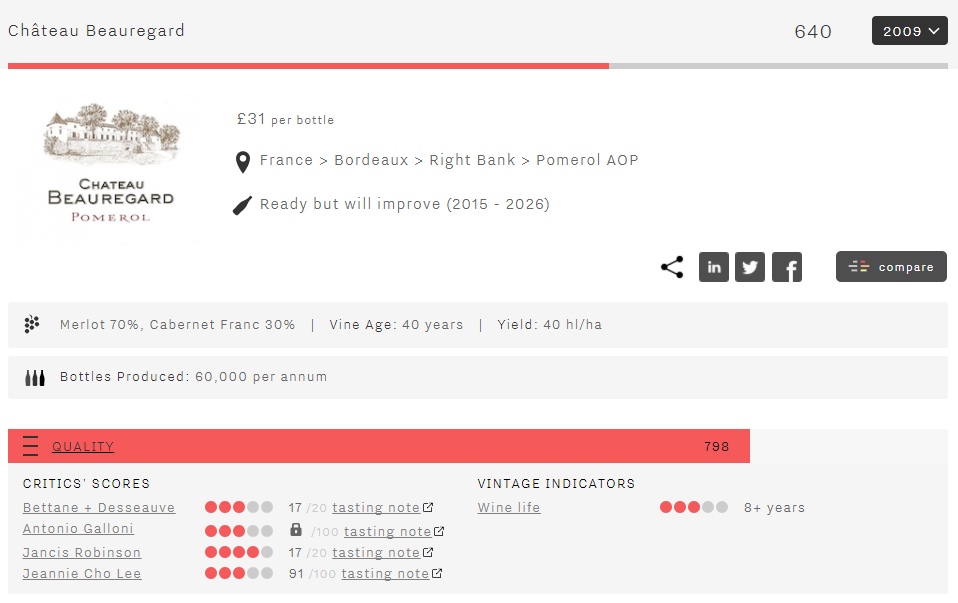
For example, we looked at the set of wine-vintages rated by both Jancis Robinson and Bettane+Desseauve, and found that wines are around 5% more likely to achieve a rating of 17 or higher from Bettane+Desseauve. Once normalised, this means that a wine such as Château Beauregard 2009, rated 17 by both Bettane+Desseauve and Jancis Robinson, achieves Wine Lister critic scores of 73 and 76 respectively. In other words, 17 is harder to get from Jancis Robinson than from Bettane+Desseauve. This is illustrated in the image above.
Once we’ve rebased and normalised the critics’ scores, we simply take an average of those scores, giving an equal rating to each of our four partner critics, each of whom represents one of the world’s key fine wine markets.
There’s still more… The Wine Lister Quality score also takes into consideration a wine’s ageing potential as defined by critics’ drinking windows – watch this space for a further explanation of how that works!
We are thrilled to announce the addition of Jeannie Cho Lee MW as Wine Lister’s fourth partner critic, representing the Asian market.
Wine Lister gathers data from multiple sources to assess thousands of wines on a truly holistic basis. Scores are made up of three main categories: Quality, Brand, and Economics. Critic ratings form a vital part of the Quality category, providing reliable scores and drinking window information.
Jeannie Cho Lee is an independent wine critic, a university professor, and an award-winning author who in 2008 was the first Asian to become a Master of Wine. Based in Hong Kong, she writes about wine on her website, www.jeanniecholee.com, and has also published several books, including Asian Palate.
Adding to our unique collaborations with three of the most reputable wine critics in the world’s major fine wine markets – Jancis Robinson (UK), Antonio Galloni (Vinous) (USA), and Bettane+Desseauve (France) – we are delighted to welcome Jeannie Cho Lee to represent the key Asian fine wine market. This careful addition will help us in our goal of providing ever more reliable and accurate ratings and analysis, while crucially maintaining the high standards of this elite pool of critics. Jeannie Cho Lee’s scores have been added to those of our existing partner critics, and fed into Wine Lister’s bespoke algorithm to produce a Quality score out of 1,000 points. Wine Lister takes each critic’s minimum and maximum wine ratings and spreads these back out over the entire scale. As each wine critic scores differently (not just on a different scale), we also account for the frequency of ratings and normalise scores for fair comparison. Each critic is weighted equally.
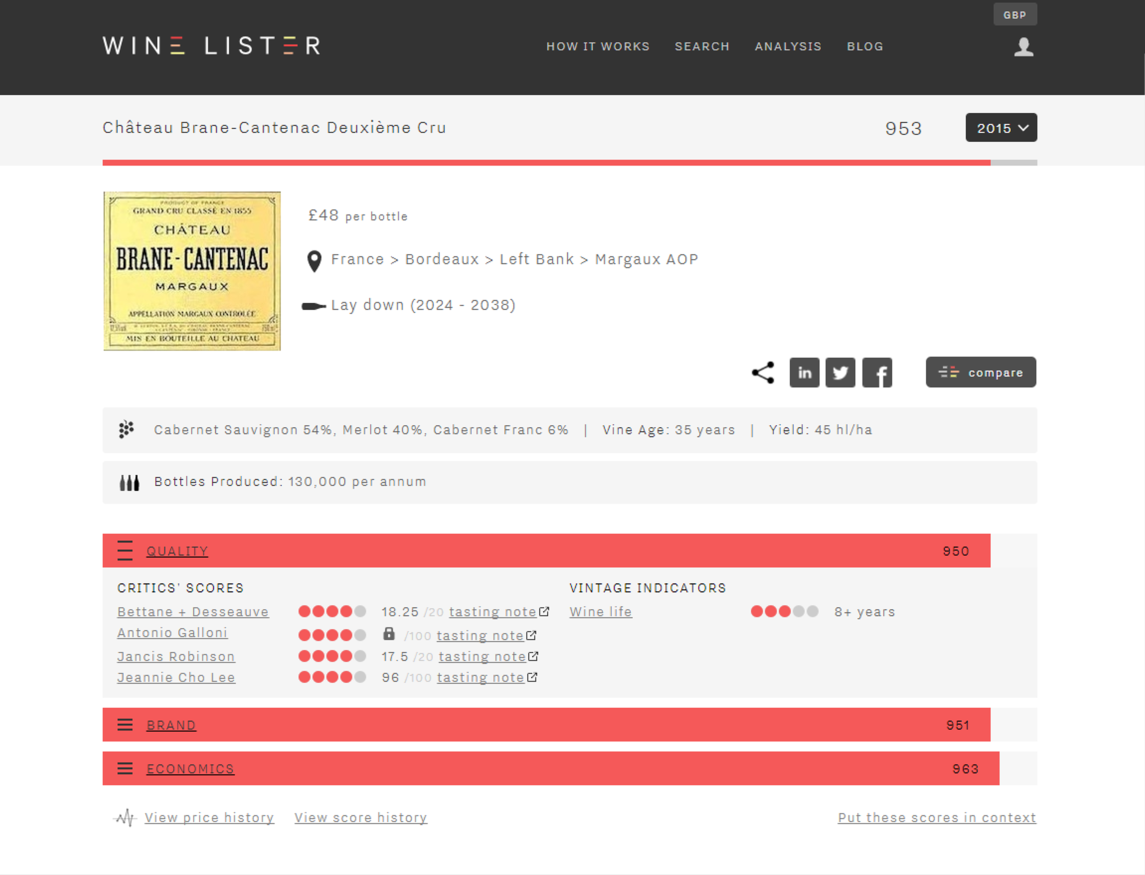
You may notice that some scores have changed for wines that have not been rated by Jeannie. In order to meet our goal of having the most comprehensive and up-to-date information, and the most rigorous rating algorithm, we have increased the sample set of scores upon which we carry out the normalisation between critics. This now includes the 18 months’ worth of new critic scores since our launch.
In an attempt to squeeze every last drop out of summer, this week’s Listed section features Wine Lister’s top 5 rosés by Quality score. Whilst the Côte d’Azur might seem a long way away, these five Provençal wines serve as a reminder of warmer climes and long sunny days.
Wine Lister’s Quality score measures a wine’s performance across two criteria – critics’ scores and ageing potential. Whilst these wines perform relatively well with the critics, they are not built with longevity in mind, and have an average predicted drinking window of just three years – compared to 17 and 16 years respectively for the top five whites and reds for Quality.
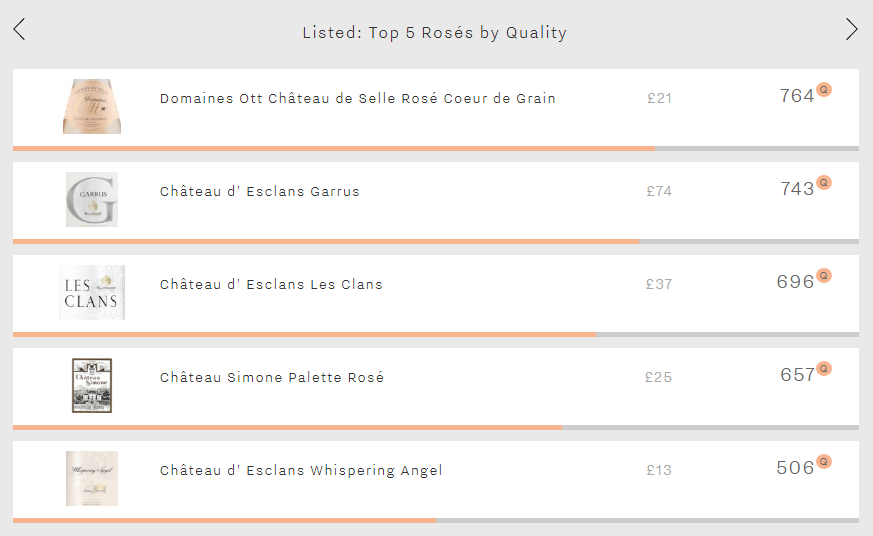
Domaines Ott Château de Selle Rosé Coeur de Grain tops the table with a very strong Quality score of 764. Currently priced at around £21 per bottle (depending on the retailer), it is the second-cheapest of the five, and represents excellent value for money.
Garrus, the first of three wines from Château d’Esclans, comes next with a Quality score of 743. At £74 it is by far the most expensive of the group – over twice as expensive as is its close relative Les Clans, with a Quality score of 696. Both these wines divide the critics, performing well with Antonio Galloni and Jancis Robinson, but less favoured by Bettane+Desseauve.
In fact, the French duo are considerably less enamoured with these five rosés than Jancis Robinson in general. Perhaps still rosé has a way to go before it is considered a serious vinous offering in France.
Château Simone Palette Rosé fills the fourth spot with a score of 657, followed by a third wine from Château d’ Esclans – Whispering Angel. Whilst it has a modest Quality score of 506, and is by far the least expensive of the group, it has by far the best Brand score (805). Proof that formidable branding can propel a wine beyond where its intrinsic quality level might suggest (though we certainly wouldn’t turn our noses up at a chilled glass of Whispering Angel on a sunny day like today).











